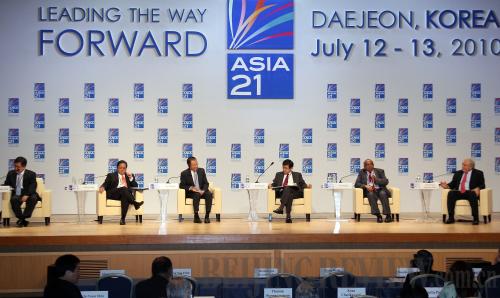|
 |
|
ATTENTION ON ASIA: Participants hold a panel discussion at the high-level "Asia 21: Leading the Way Forward" conference in Daejeon, South Korea, on July 12 (CFP) |

On July 12-13, the high-level conference "Asia 21: Leading the Way Forward" was jointly hosted by the International Monetary Fund (IMF) and the South Korean Government in Daejeon, South Korea. The importance the IMF attaches to Asia shows the role of Asia-Pacific economic development within the global framework has increased dramatically since the outbreak of the global financial crisis in 2008.
The crisis, triggered by the U.S. subprime mortgage crisis, severely impacted global financial markets. As a result, East Asian countries' export sectors were badly hit by shrinking consumer markets in Europe and the United States.
Although East Asian countries led the way out of the crisis and maintained rapid growth, the impact of the crisis revealed various new challenges their economic development models now face. How to deal with these challenges is crucial to maintaining sustained and rapid economic growth in the region.
Export bottlenecks
The development paths of East Asian countries are different, but generally speaking, they are all countries playing catch-up, as they lag behind European and U.S. economies.
Japan and South Korea took advantage of U.S. support during the Cold War, and realized economic catch-up through promoting technological advancement. In the meantime, exports played a significant role in their economic development as well.
Other countries mainly adopted export orientation as a way to catch up, despite some import substitution strategies—because an export-oriented economy not only adapts to the international division of labor in the context of economic globalization, but can also solve problems of capital and technology shortages in less developed countries.
Since the 1980s, Japan has led the pack in East Asian economic growth. The Japan-led model aimed at establishing a regional division of labor, making use of the differences in East Asian nations' development levels. It has created a regional export-oriented economy, featuring dependence of the region's overall development on exporting to countries outside the region.
But, with the region's economic growth, this development model began to suffer from bottlenecks, as evidenced in the export-oriented manufacturing sector.
Export-oriented economies can develop rapidly in their early stages through the use of their cheap labor resources as well as foreign capital, technologies and markets.
But with their expansion, the driving force provided by exports will inevitably decline. There are several reasons for this. First, due to low added value, manufacturing for export can only make profits by selling a large quantity of products. But it is difficult to increase dramatically once a certain level is reached.
In addition, manufacturing industries are mostly labor-intensive. When an economy develops to a certain level, human resource costs will rise, thus undermining industrial advantages.
What's more, if a country's economic growth depends on export-oriented manufacturing in the long term, it will be restrained by changes in external economic environments, and it will become difficult to achieve sustained growth.
The impact of the world financial crisis has brought home to the region the shortcomings of excessive dependence on exports. Upgrading the development model has become a consensus of the region.
Transition challenges
Usually, people think an export-oriented economy should transit to an economy mainly depending on domestic demand. This is not always the case. Take Japan for example. The United States has requested it to implement economic transition for 20 years but, so far, the Japanese economy still depends heavily on exports. The two developed economies of East Asia, Japan and South Korea, now have very limited space for domestic economic growth.
The economic pattern in the region has undergone fundamental restructuring because of the rapid development of China's economy in recent years. China is replacing Japan to become the economic leader in East Asia. While promoting growth through exports, China has also established a huge domestic market, and become a major destination for investment from Japan and South Korea.
China is rapidly catching up with Japan in terms of the size of their economies. Therefore, how China carries out its economic transition will have great significance for East Asia.
One of the main reasons why East Asia has been able to overcome the financial crisis quickly is China stimulated its domestic economy through huge government investment.
China is in the process of industrialization. Coupled with this process is urbanization, which requires considerable infrastructure construction. Government-sponsored infrastructure construction constitutes a major part of China's economic growth. But domestic demand dependent on government investment is not sustainable.
Therefore, how to stimulate consumer demand is a vital subject for China as well as all other East Asian countries.
The problem with China's economic structure is not in its reliance on exports, but in its reliance on the export of manufactured goods. Manufacturing is at the low end of the value chain, which puts China at a disadvantaged position in international wealth distribution.
When it comes to domestic income distribution, Chinese workers' share is too small. As a result, the growth of consumption capacity in China falls far behind its economic growth.
Moreover, Chinese residents' desire for consumer goods is restrained by many uncertain factors. For instance, given China's high housing prices, home purchases take up such a large proportion of Chinese consumers' income that their consumption capacity is severely weakened.
For China, a transition from an export-oriented economy to growth driven by domestic demand does not simply mean selling more products at home. More importantly, it calls for technological innovation to develop high-end products.
| 